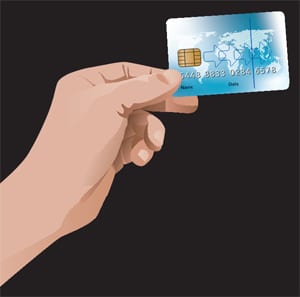CORPORATE CARDS GO GLOBAL AND VIRTUAL
Companies are reworking their corporate card programs and setting up new corporate purchase card programs to improve spend management and gain greater control over global expenses.
By Denise Bedell
 Companies are always looking to cut costs, but that desire has been heightened over the past year as they struggle with closed markets and liquidity concerns. As a result, many corporates are re-examining their commercial card programs, writing clearer policies to enforce card use and investigating new purchase card (p-card) programs on offer from their banks.
Companies are always looking to cut costs, but that desire has been heightened over the past year as they struggle with closed markets and liquidity concerns. As a result, many corporates are re-examining their commercial card programs, writing clearer policies to enforce card use and investigating new purchase card (p-card) programs on offer from their banks.
Many companies have found that they can cut costs significantly in a fairly short period of time by deploying corporate cards, and as a result their use has grown substantially over the past year. “There is still a large opportunity in indirect purchases—smaller dollar-value items for supplies or MRO [maintenance, repair and operations] purchases,” says Nancy Atkinson, a senior analyst at consultancy Aite Group. “Many are still done by check, or even cash in some cases. P-cards save companies a lot of money on lower dollar-value purchases.”
 |
|
|
In addition to p-cards, more and more companies are mandating corporate cards for travel spending. Hubert Jolly, global head of cards and procure-to-pay in Citi’s Global Transaction Services division, notes: “Once a corporate can mandate all spend through their travel card program, they can use more reporting tools so the travel manager can see how much they spend with each service provider, airline and so on. It gives them a lot more control of with whom they spend, and then they can reduce their travel providers and renegotiate better terms.”
From a supplier perspective, cards are also on the rise as a payment method as their use can significantly reduce their days payable outstanding (DPO). Kevin Phalen, treasury and merchant product executive at Bank of America Merrill Lynch, says: “With the challenging economic times and with liquidity concerns, smaller companies are accepting cards more as a way to shorten payment cycles. Instead of a 45-day payment term, companies are saying, ‘Pay me through a purchase card,’ so they can receive payment more quickly.” He adds that typically when companies bolster their card program or initiate a new program, indirect spending—smaller ticket items—end up moving from check or even from electronic payment to a card.
Despite their surge in popularity among corporate users, p-cards still face a major problem with acceptance. According to research from Aite Group, only 16% of US business-to-business suppliers will accept commercial cards because of the cost associated with such transactions. The supplier is solely responsible for the cost of a transaction, and they are priced as a percentage of the purchase amount. For high-dollar purchases this makes it much more expensive than fixed-fee electronic payment channels such as Fedwire or ACH.
Purchase Card Pitfalls
In addition, as a result of the current fee structure for card transactions, those issuing banks and networks that want to build market share and grow their lucrative p-card business regularly ignore a fundamental card network rule—that of card-acceptance discrimination. Network regulations prohibit suppliers from discriminating based on purchase size—meaning, if they are going to accept cards for small purchases (where the transaction cost is low), they have to accept them for larger purchases (where the transaction cost is high). Many suppliers routinely accept cards for low-value transactions while refusing higher-value ones, but seldom has any bank or network called them on it. When they do, the supplier generally just gets a small slap on the wrist—nothing to actually discourage the practice.
 |
|
|
Proponents of corporate cards, and p-cards in particular, have been pushing for changes to the network and issuer transaction pay structure for quite some time, proposing that p-cards move to a fixed-fee structure, at the very least for higher-value payments. Should that happen, p-cards could see an explosion of interest from companies and acceptance by suppliers.
At a time when most companies are being very frugal with capital spend and staffing, company executives also worry about the time and resources necessary for setting up a program. Notes one vendor: “The downside is that there is some amount of disruption in enabling a program. If you haven’t had an automated way of controlling policies and procedures for purchasing, then it will take some staff training and re-education.” Employees must understand when they can and cannot use their cards for purchases and with whom they are allowed to make purchases.
As a result, many companies are starting to roll out virtual card programs—where a single account is used and there is no physical card. Purchases are made through approved vendors that are given the account information for that purchase. It provides much greater control as dollar values and approved vendors can be specified and purchases approved at the point of sale.
“People are really looking at managing their resources tightly right now and may view rolling out a full travel card or purchase card program as taking too much time or too many resources,” says Citi’s Jolly. “But that is not always the case. They need to ask their bank what it will take and what resources the bank can provide to roll it out.”
The other issue faced by companies trying to implement card programs is the global nature of business. With different payment regulations in every country, it is quite difficult to set up a globally integrated p-card program. Should a company choose to roll out its p-card program on a global basis, it takes time and dedicated resources to bring it all together.
Nonetheless, a number of large multinationals are working on just that: rolling out existing US-based p-card programs internationally. “In the United States we are still seeing a large push from check to electronic payments,” says Bank of America Merrill Lynch’s Phalen. “While we may be seeing less business-to-business spend, that push to electronic payments is driving growth in purchase cards. In the rest of the world purchase cards are still relatively new, and we are seeing growth in particular as companies push their non-US entities to use purchase cards.”
Most often global card programs will be rolled out as virtual or ghost cards. As they grow in the US, many multinationals want to be able to take advantage of the program internationally. As more countries are accepting the tax implications of allowing p-card usage, it is getting easier.
From a bank perspective, not only do cards offer a lucrative revenue stream, but also they are a mechanism to help create tighter bonds with clients. Making p-cards part of their larger supply chain offerings enables banks to gain greater insight into their clients’ supply chain and global trade activities. “In today’s economy, understanding clients’ trading partner agreements and having a view of payments activity allows a bank to target services that support their clients’ trading partners in addition to their client,” says Aite Group’s Atkinson.
The key to any successful program, according to Jolly, is policy and enforcement. “Typically, most large corporates already have a card program, so it comes down to policy,” he says. “They need to write very clear spend policies and ensure that they are enforcing those policies.”
|
NEW TECHNOLOGY CHANGES THE FACE OF CORPORATE CARDS The biggest advances in the world of corporate cards are the advent of prepaid cards and the growing use of virtual cards. “Issuing prepaid cards is growing the fastest of all B2B card vehicles, as companies demand such cards for payroll, incentive programs and health benefits,” says Nancy Atkinson at consultancy Aite Group. Their proponents say companies like the prepaid cards because they can provide enhanced control for HR processes. However, prepaid cards do not have the flexibility of a virtual card or p-card program. The virtual or ghost card—also called a virtual accounts payable card—allows different functional areas within a company to use a single account for purchasing. Various departments can order against the same virtual card and aggregate data for procurement purposes—including who is ordering what and when, and how much it is costing. This gives the procurement manager great leverage in dealing with suppliers and getting discounts. In addition, it encourages acceptance of larger purchases through the program, as it can be approved at the point of sale by the procurement manager. Probably the most important advance from a corporate perspective is the data and controls that new solutions can pull out of card transactions and corporates can use to drive processes. The value of that data is quite a useful element of any card program. Petra Stange, head of corporate cards at Deutsche Bank, notes: “We are integrating the card business into the overall value chain of cash management. On the corporate card side we are constantly finding solutions to integrate the spending behavior of corporates and their needs within the overall cash management environment.” However, although many vendors can and do offer advanced reporting and data collation solutions, many companies cannot take advantage of it. On the corporate back end, many corporate accounting systems were designed to deal with checks and may have been adapted to handle ACH and wire transfers. In order to really use the data that is available, it takes integration with corporate enterprise resource planning (ERP) systems, accounting systems and so on. That can take time and effort. Some banks will offer invoice-matching services to bring that data together, but it is hardly the integrated functionality that the most advanced systems promise. For many companies, some evolution still needs to take place on the corporate back end in order to create true straight-through processing between corporate card payment channels and corporate accounts payable and receivable functions. |



